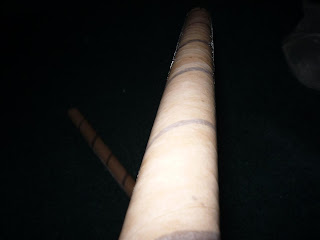My next rocket is a minimum diameter, high performance mach breaker that will fly on C through I motors. The rocket is 29mm in diameter and will be around 34 inches long. It should be capable of easily achieving mach 1.5 to 1.7 on I motors and attain altitudes of 9000 to 10000 feet. It will be streamer recovery, and include my tracking transmitter, and a recording only altimeter.
Rocksim screenshots shown empty, and with the largest 29mm motor made, the I224 Classic from CTI.
The simulation data.
I started with the fins. I layed up 6 layers of 10oz./sq.yrd. fiberglass cloth, alternating the angles at each layer. The cardboard bits are mockups of the fins.
The layup, wetted out with West System's 206 epoxy.
The fin layup was clamped between 2 layers of plywood and plastic sheeting.
Once cured, I drew the fins out on the fiberglass.
The rough cut fins.
I sanded the edges to the correct dimensions.
Some rough beveling was done by hand.
The fins are completed here. The beveling is sharp, and the fins ended up at about 1/16th of an inch thick and weigh 3 grams each.
This is the layout of the parts. I did this to figure out where to cut the tube. The motor case is the CTI Pro29 6GXL case, the largest 29mm commercially made. The caution tape will work well as the streamer. I have removed the tracker from its case to allow it to fit into the 29mm tube. The paper cutout shows the length and width of the altimeter I will get for this rocket, the Pnut from Perfect Flite. I will be custom turning the coupler tube and nose cone from balsa.
Here's the nice clean cut at the separation point of the payload bay. To do this, I used a paper wrap as a guide, and then built up a layer of masking tape. I used the masking tape as a guide to cut against. I placed the motor case inside the tube to prevent the tube from crushing while cutting.
I bought some light, 1.5 oz./sq.yrd. fiberglass cloth to glass the body tubes and to do the tip to tip fiberglassing of the fins.
I peeled the shiny, smooth layer from the tubes to allow the epoxy to soak in. I cut the fiberglass wide enough to wrap around for 2 layers in one session.
Once wrapped, I rolled some plastic sheet around the tubes and did a tape wrap of electrical tape. This squeezes the fiberglass nice and tight against the tube and squeezes extra epoxy out, saving weight and making the tube stronger.
The finished booster tube.
The fiberglassed payload tube.
Next, I will be removing the tape wrap and doing some filling and sanding of the fiberglass. I will also be ready to attach and reinforce the fins.


























































